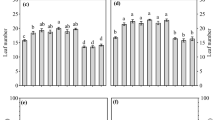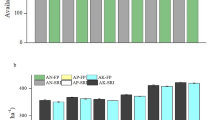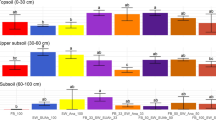Abstract
The consecutive monoculturing of peanut seriously affects its yield and quality in the red soil regions of southern China. Different control measures for consecutively monocultured peanut fields should be explored to ensure the sustainable development of the local peanut industry. In this study, the influence of two different regimes, the intercrop** of peanut with Atractylodes lancea and the furrow application of bio-organic fertiliser (BOF), on the community composition of soil invertebrates, the severity of peanut disease and peanut productivity was evaluated in an upland region where peanut had been monocrop** for 5 years. We found that intercrop** with A. lancea and the furrow application of BOF significantly changed the community composition of soil invertebrates and increased their biodiversity, as estimated by the Shannon and Simpson indices. Intercrop** with A. lancea significantly reduced the proportion of Collembola, such as Tullbergia, Onychiurus, Folsomia and Folsomina, while the furrow application of BOF significantly increased the abundance of Collembola, such as Isotomidae compared with conventional monoculture. The intercrop** significantly increased the proportion of Acarina, such as Mesostigmata and Oribatida, whereas the furrow application of BOF did not increase this proportion compared to conventional monoculture. The intercrop** and application of BOF significantly reduced the dam**-off in seedling and root rot disease at the maturation stage and increased peanut yield. The leaf spot disease of peanut was significantly suppressed by the intercrop** but not by the application of BOF. The results of the study suggested that the intercrop** of peanut with A. lancea and the furrow application of BOF could effectively relieve the problems associated with consecutive monoculture of peanut in the red soil regions of southern China.


Similar content being viewed by others
References
Abdel-Monaim M, Abo-Elyousr KAM (2012) Effect of preceding and intercrop** crops on suppression of lentil dam**-off and root rot disease in New Valley—Egypt. Crop Prot 32:41–46
Armanious AH (2000) Studies on some cotton diseases. MSc thesis, Faculty of Agriculture, Minia University
Bolger T, Curry JP (1984) Influences of pig slurry on soil microarthropods in grassland. Rev Ecol Biol Sol 21:269–281
Burke DW, Miller DE (1983) Control of Fusarium root rot with resistant beans and cultural management. Plant Dis 67:1312–1317
Butcher JW, Snider R, Snider RJ (1971) Bioecology of edaphic Collembola and Acarina. Ann Rev Entomol 16:249–288
Celik I, Ortas I, Kilic S (2004) Effects of compost, mycorrhiza, manure and fertilizer on some physical properties of a Chromoxerert soil. Soil Tillage Res 78:59–67
Chen Y, Wang HW, Li L, Dai CC (2013) The potential application of the endophyte Phomopsis liquidambari to the ecological remediation of long-term crop** soil. Appl Soil Ecol 67:20–26
Dai CC, Yuan ZL, Yang QY, Shi QS, Li X (2008) The effects of increasing production of endophytes Phomopsis B3 on rice. Agric Sci Technol 9:39–42
Dai CC, ** peanut with traditional Chinese medicinal plants improves soil microcosm environment and peanut production in subtropical China. Afr J Biotechnol 8:3739–3746
Dai CC, ** with medicinal plants and addition of endophytic fungi on soil microflora and peanut yield. Acta Ecol Sin 30:2105–2111
Dai CC, Chen Y, Wang XX, Li PD (2013) Effects of intercrop** of peanut with the medicinal plant Atractylodes lancea on soil microecology and peanut yield in subtropical China. Agrofor Syst 87:416–427
FAO (1998) FAO, ISRIC, ISSS World reference base for soil resources. World soil resources reports 84. Rome, Italy
Filser J (2002) The role of Collembola in carbon and nitrogen cycling in soil. Pedobiologia 46:234–245
Francis CA (1990) Potential of multiple crop** systems. In: Altieri MA, Hecht SB (eds) Agroecology and small farm development. CRC Press, Boca Raton, pp 137–150
Franklin E, Magnusson WE, Luizão FJ (2005) Relative effects of biotic and abiotic factors on the composition of soil invertebrate communities in an Amazonian savanna. Appl Soil Ecol 29:259–273
Gil VS, Haro R, Oddino C, Kearney M, Zuza M, Marinelli A, March GJ (2008) Crop management practices in the control of peanut diseases caused by soilborne fungi. Crop Prot 27:1–9
Gómez-Rodríguez O, Zavaleta-Mejía E, González-Hernández VA, Livera-Muñoz M, Cárdenas-Soriano E (2003) Allelopathy and microclimatic modification of intercrop** with marigold on tomato early blight disease development. Field Crops Res 83:27–34
Hao YM, Dai CC, Dai ZD, Gao X (2012) The effect of Phomopsis B3 and organic fertilizer used together during continuous crop** of strawberry (Fragaria ananassa Duch). Acta Ecol Sinica 32:6695–6704
Hu J, Lin X, Wang J, Shen W, Wu S, Peng S, Mao T (2010) Arbuscular mycorrhizal fungal inoculation enhances suppression of cucumber Fusarium wilt in greenhouse soils. Pedosphere 20:586–593
Hwang SF, Ahmed HU, Gossen BD, Kutcher HR, Brandt SA, Strelkov SE, Chang KF, Turnbull GD (2009) Effect of crop rotation on the soil pathogen population dynamics and canola seedling establishment. Plant Pathol J 8:106–112
Joshi D, Hooda KS, Bhatt JC, Mina BL, Gupta HS (2009) Suppressive effects of composts on soil-borne and foliar diseases of French bean in the field in the western Indian Himalayas. Crop Prot 28:608–615
Kautz T, López-Fando C, Ellmer F (2006) Abundance and biodiversity of soil microarthropods as influenced by different types of organic manure in a long-term field experiment in Central Spain. Appl Soil Ecol 33:278–285
Latha P, Anand T, Prakasam V, Jonathan EI, Paramathma M, Samiyappan R (2011) Combining Pseudomonas, Bacillus and Trichoderma strains with organic amendments and micronutrient to enhance suppression of collar and root rot disease in physic nut. Appl Soil Ecol 49:215–223
Lavelle P, Decaëns T, Aubert M, Barot S, Blouin M, Bureau F, Margerie P, Mora P, Rossi JP (2006) Soil invertebrates and ecosystem services. Eur J Soil Biol 42:S3–S15
Lazcano C, Gómez-Brandón M, Revilla P, Domínguez J (2012) Short-term effects of organic and inorganic fertilizers on soil microbial community structure and function. Biol Fertil Soils 49:723–733
Leroy BLMM, Bommele L, Reheul D, Moens M, Neve SD (2007) The application of vegetable, fruit and garden waste (VFG) compost in addition to cattle slurry in a silage maize monoculture: effects on soil fauna and yield. Eur J Soil Biol 43:91–100
Li PD, Wang XX, Li YL, Wang HW, Liang FY, Dai CC (2010) The contents of phenolic acids in continuous crop** peanut and their allelopathy. Acta Ecol Sin 30: 2128–2134
Li PD, Dai CC, Wang XX, Zhang TL, Chen Y (2012) Variation of soil enzyme activities and microbial community structure in peanut monocrop** system in subtropical China. Afr J Agr Res 7:1870–1879
Lindberg N, Persson T (2004) Effects of long-term nutrient fertilization and irrigation on the microarthropod community in a boreal Norway spruce stand. Forest Ecol Manag 188:125–135
Lundgren JG, Shaw JT, Zaborski ER (2006) The influence of organic transition systems on beneficial ground dwelling arthropods and predation of insects and weed seeds. Renew Agr Food Syst 21:227–237
Magurran AE (2004) Measuring biological diversity. Blackwell Science, Oxford
Minuto A, Davide S, Garibaldi A, Gullino ML (2006) Control of soil-borne pathogens of tomato using a commercial formulation of Streptomyces griseoviridis and solarization. Crop Prot 25:468–475
Miyazawa K, Tsuji H, Yamagata M, Nakano H, Nakamoto T (2002) The effects of crop** systems and fallow managements on microarthropod populations. Plant Prod Sci 5:257–265
Nakamura Y (1976) Decomposition of organic materials and soil fauna in pastures 4. Disappearance of cow dung and succession of the associated soil-microarthropods. Pedobiologia 16:243–257
Niemela J, Haila Y, Puntilla P (1996) The importance of small-scale heterogeneity in boreal forests: variation in diversity in forest-floor invertebrates across the succession gradient. Ecography 19:352–368
Pavlou GC, Vakalounakis DJ (2005) Biological control of root and stem rot of greenhouse cucumber, caused by Fusarium oxysporum f. sp. radicis-cucumerinum, by lettuce soil amendment. Crop Prot 24:135–140
Pflug A, Wolters V (2001) Influence of drought and litter age on Collembola communities. Eur J Soil Biol 37:305–308
Potts GR, Vickerman GP (1974) Studies on the cereal ecosystem. In: MacFadyen A (ed) Advances in ecological research. Academic, New York
Rojo FG, Reynoso MM, Ferez M, Chulze SN, Torres AM (2007) Biological control by Trichoderma species of Fusarium solani causing peanut brown root rot under field conditions. Crop Prot 26:549–555
Siemann E, Tilman D, Haarstad J, Ritchie M (1998) Experimental tests of the dependence of arthropod diversity on plant diversity. Am Nat 152:738–750
Soleimani MJ, Deadman ML, McCartney HA (1996) Splash dispersal of Pseudocercosporella herpotrichoides spores in wheat–clover bicrop canopies from simulated rain. Plant Pathol 45:1065–1070
Suman K, Sugha SK, Kumar S (2000) Role of cultural practices in the management of Septoria leaf spot of tomato. Indian Phytopathol 53:105–106
Sutherland WJ (1996) Ecological census techniques: a handbook. Cambridge University Press, Cambridge
Tenuta M, Lazarovits G (2002) Ammonia and nitrous acid from nitrogenous amendments kill the microsclerotia of Verticillium dahlia. Phytopathology 92:255–264
Treonis M, Austin EE, Buyer JS, Maul JE, Spicera L, Zasada IA (2010) Effects of organic amendment and tillage on soil microorganisms and microfauna. Appl Soil Ecol 46:103–110
Vreeken-Buijs MJ, Hassink J, Brussaard L (1998) Relationships of soil microarthropod biomass with organic matter and pore size distribution in soils under different land use. Soil Biol Biochem 30:97–106
Wang MZ, Chen XN (2005) Obstacle and countermeasure of sustainable high yield for peanut in low-hilly red soil region. J Peanut Sci 34:17–22
Yin WY (1998) Pictorial keys to soil animals of China. Science Press, Bei**g
Zewde T, Fininsa C, Sakhuja PK, Ahmed S (2007) Association of white rot (Sclerotium cepivorum) of garlic with environmental factors and cultural practices in the North Shewa highlands of Ethiopia. Crop Prot 26:1566–1573
Acknowledgments
This research was jointly supported by the National Natural Science Foundation of China (41201281, 41371290), the Special Fund for Agro-scientific Research in the public interest, China (No. 201203050), the Knowledge Innovation Program of Chinese Academy of Sciences (ISSASIP1107), and the Jiangsu Province Science Foundation for Youths (BK2012498).
Author information
Authors and Affiliations
Corresponding author
Electronic supplementary material
Below is the link to the electronic supplementary material.
Rights and permissions
Received:
Accepted:
Published:
Issue Date:
DOI: https://doi.org/10.1007/s10457-013-9653-6




